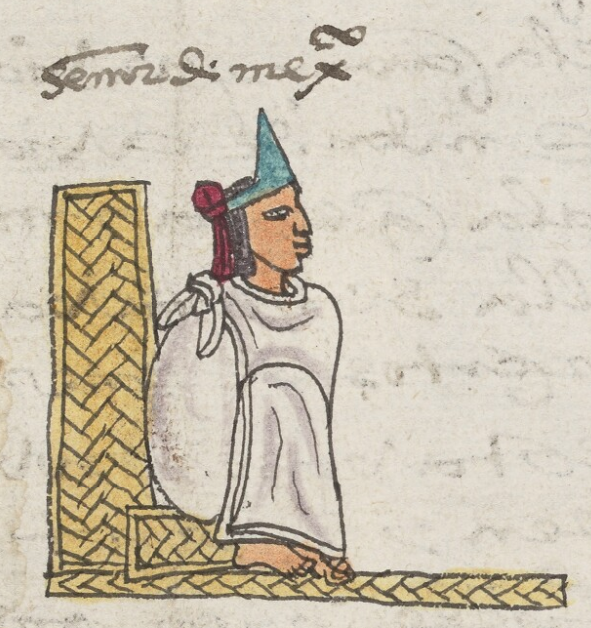in petlatl, in icpalli (Mdz68r)
This compound glyph includes a woven, upright seat with a backing and meant for a ruler was called an (icpalli). The other component is a thinner mat (petlatl) that extends out in front of this seat. The two combined signify the authority of a ruler (tlatoani, or tlahtoani, with the glottal stop) who would sit on the seat. The back rest that is shown in this example is two times the length of the seat. This example is included here for making comparisons with glyphs of woven mats and other woven seats. There is no gloss identifying this metaphoric glyph, but we are fairly certain of its identification.
Stephanie Wood
This is a visualization of the diphrasism in petlatl, in icpalli (authority) that is associated with rulers (tlatoque) (or tlahtohqueh, with the glottal stops). This seat could also be called a tolicpalli when it was woven from an acuatic plant (tolin) called espadaña or tule in Spanish. The term tolicpalli appears in Sahagún's Florentine Codex, Book 8, chapter 11. All of these seats are indicative of high social status. This is supported by the gloss in the contextualizing image, "Señor di Mexco" (Lord of Mexico).
Katarzyna Mikulska (2020, 52-54) discusses the possibility for diphrases and metonymic series (after Dehouve) to be "represented graphically." She also gives this example from the Codex Mendoza, along with the expressions for arrow and shield and the flood and conflagration. See also Mercedes Montes de Oca Vega's discussion of couplets in Mexicolore.
Stephanie Wood
c. 1541, or by 1553 at the latest
Stephanie Wood
seats, thrones, asientos, tolicpalli, tules, taburete de estería, esteras, petates, difrasismo, couplets
petla(tl), woven mat, https://nahuatl.wired-humanities.org/content/petlatl
icpal(li), seat of status, throne, https://nahuatl.wired-humanities.org/content/icpalli
la autoridad, la gobernancia
Stephanie Wood
Codex Mendoza, folio 68 recto, https://digital.bodleian.ox.ac.uk/objects/2fea788e-2aa2-4f08-b6d9-648c00..., Image 146 of 188.
Original manuscript is held by the Bodleian Libraries, University of Oxford, MS. Arch. Selden. A. 1; used here with the UK Creative Commons, “Attribution-NonCommercial-ShareAlike 3.0 License” (CC-BY-NC-SA 3.0)



